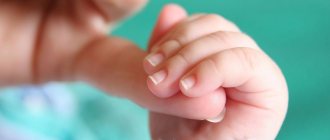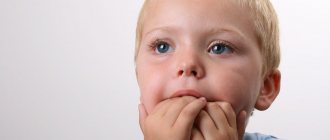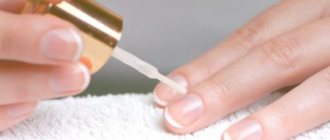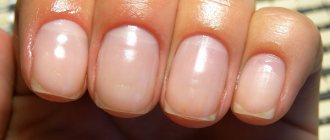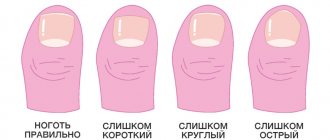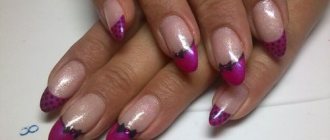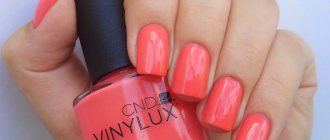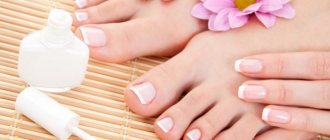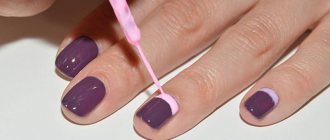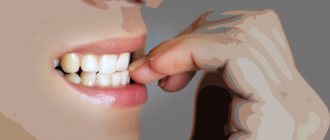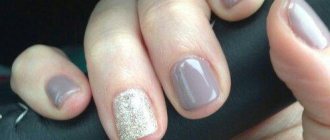July 27, 2018
Averyanova Sveta
The baby’s bad habits are condemned by the people around him: biting the tips of his nails, thumb sucking, picking his nose - ugly and unhygienic. But rarely does anyone think that harmful inclinations are often not a gap in upbringing, but a consequence of an unfavorable psychological state. Therefore, it is important not only to find a method to stop a child from biting his nails, but also to solve the problem in the relationship.
Why does a child bite his nails?
There are many reasons why a child bites his nails. The root of a bad habit is usually psychosomatics. The tendency appears in infancy. It is common for a small child to put something in his mouth in moments of mental discomfort. Most often, the baby uses his own fingers for this purpose, since they are always available. The next symptom: the baby begins to bite his nails, then the habit is completely formed.
Any stressful situation becomes a trigger: the first trip to kindergarten, quarrels between parents, change of place of residence. A child may start biting his nails in the following cases:
- If someone around him suffers from a bad habit. According to statistics, half of the parents of preschoolers observe its manifestations. If a mother or father walks around in a family with bitten nails, the child will almost certainly become infected.
- Boredom. Preschoolers have a great need for tactile sensations. When children rarely engage in modeling, design, or other activities, and have little interest in the world around them, they can find solace by chewing their nails.
- Failure to comply with hygiene requirements.
Overgrown nails bother the baby, and he gets rid of the discomfort in an accessible way. - In case of illness. Ailments make the baby anxious and vulnerable.
- Against the background of a lack of vitamins and minerals. Children need a variety of foods. With a monotonous, bland diet, a lack of vitamins E and B, and magnesium, the nervous system does not work ideally, and the desire to chew on something appears.
- To spite the parents. A habit is formed if parents scold a child for sucking his thumb or picking his nose. The baby will protest in a different form.
- With increased excitability. In moments of excitement: when watching scary cartoons, high information load, while waiting for something significant, even adults feel the need to touch their face or rub their hands. What can we say about kids with their unformed ability to calm down?
Common causes of nail biting
Many people get rid of their habit over time and do not remember their habit, and some do it reflexively, without even noticing this action. Today, the problem is inherent in children and worries parents very much.
The habit of biting the nail plate is called onychophagia. It is associated with several factors, including mental disorders provoked by stress and emotions.
Most often, children aged 4 years are susceptible to the habit. During this period, the baby, due to various unfavorable factors, begins to involuntarily bite his nails. The problem does not cause global harm to health, but causes problems due to the development of this habit, which develops into a permanent one, thereby changing the shape of growing nails and contributing to the development of inflammatory processes of the cuticles and bruises.
The main reasons for the development of onychophagia are:
- hereditary predisposition - based on the subconscious level and laid down by the genes of parents who have this style;
- brittle nails – can cause biting of the nail plate due to constant peeling and brittleness due to a lack of calcium in the body;
- a lack of keratin in the body can provoke a problem due to an acute lack of vitamin A in the body;
- psychology - nail biting is caused by psychological factors and unstable emotional lability.
Onychophagia with constant exposure can be dangerous, since damaging the nail plate can lead to infections that can lead to inflammatory processes.
Age characteristics
The prerequisites for harmful actions depend on the age of the child. A baby can suck his thumb after he has been abruptly weaned from the breast or his pacifier has been taken away. Both one-year-old and two-year-old toddlers usually suffer during teething. In late preschool age, permanent teeth replace baby teeth, creating a feeling of discomfort.
Here are the periods during which you should be more attentive and gentle with your child:
- Admission to kindergarten or school. It’s rare that adaptation to new conditions proceeds painlessly. Children pick up bad tendencies from each other much faster than good ones.
- Age-related turning points, for example the well-known crisis at three years. It may not affect the baby at all, it can be observed in both the second and fourth years of life and turn a sweet angel into a restless rebel. At this moment, it is important for the child to assert himself by overstepping the parents’ ban on biting his nails.
- Moving to another city, apartment, stressful situations in the family.
- Difficulty doing homework. Boredom, lack of interest in a subject, or an exercise that is too difficult are also reasons to form a bad habit. Most often boys are susceptible to it.
Nail mask with red pepper at home
Are there any harms and contraindications?
Masks based on red pepper belong to the category of products with a rather aggressive effect. That is why it is recommended to use them no more than twice a month. When the desired result is achieved, they are used once every thirty days to prevent brittle nails. Masks with a small amount of red pepper can be used weekly.
What's the harm?
Judgment from others is not the only negative result of nail biting. The consequences include:
- The risk of infectious diseases and the formation of helminthic infestations. Dirt accumulated under the nails remains even after washing your hands.
- Deformation of the nail, most often irreversible, reduction in the size of the nail plate.
- Inflammation of the skin on the outside of the fingertips, risk of inflammation of open small wounds, infection through the bloodstream.
- Violation of social connections: ridicule and teasing of peers, alienated attitude of adults.
What are the dangers of onychophagia?
Of course, this obsessive state cannot be compared with alcoholism and drug addiction. However, biting the nail plate is not completely safe. Indeed, the consequences of such actions can negatively affect both a person’s health and his relationships with others.
- This habit can provoke intestinal infections, parasitic diseases, and poisoning.
- Damage to the skin around the nail plate and infection of wounds (their suppuration, inflammation, even blood poisoning).
- A detrimental manner makes the hands untidy.
- A person with such a habit has no respect in society.
Even regular nail polish can help deal with this problem if it is chosen correctly (this method is more suitable for women). After all, no girl wants to ruin a beautiful manicure, and if a lot of money was spent on it, then you can forget about your behavior for a long time. The main thing is to get your hands in order on time.
Recommendations from psychologists
General advice boils down to the following: by scolding and punishing a child, parents will increase stress, the child will begin to bite his nails more often or acquire another habit, much worse. Orders, threats and prohibitions will not work. It’s better to gently explain to your son that nail biting is not the job of a real man, and tell the girl that biting her cuticles is very unsightly, and give her an elegant manicure.
Here are general recommendations for parents:
- Follow the daily routine, review the diet of the whole family.
- If a specialist has prescribed treatment, follow all instructions.
- Try art therapy to help cope with fears: offer to draw a frightening situation, your family, mold a dangerous creature and crush it. Write a story about a boy or girl the same age as the child who overcomes a habit.
- Provide exercise in the fresh air. You can enroll your child in creative courses or in a sports club, where he will give free rein to his feelings.
Skin contact is very important. Hugs, bedtime massages, and pats on the head signal the baby’s well-being and acceptance, and positive emotions will alleviate stress.
Important! When you see a child biting his nails, do not raise your voice, slap his hands or call him names. Shift your attention to something positive.
Types and methods of application
The modern market offers a wide range of varnishes for children who bite their nails. It is worth considering several varieties that have already gained popularity:
- Smart enamel “Gnaw - I don’t want to.” Looks like regular nail polish. This product is often bought for boys because they don’t like doing manicures. And smart enamel has no color, so it is practically invisible on the nails. It can be applied to both hands and feet. It has added cactus extract, which provides a strong bitterness.
It dries very quickly and does not cause irritation, even if it gets on damaged skin. If the child flatly refuses coverage, then this procedure can be performed even in his sleep. The varnish will dry quickly and will not cause discomfort to the baby.
However, some parents noted that the bitterness is quickly washed off with water.
- Princess "Nekusayka". It has a disgusting taste that quickly discourages children from biting their nails. It is noted that getting rid of the habit takes from several days to 2 weeks.
The manufacturer advises applying the product before bed so that the bitter substances included in its composition have time to show themselves in all their glory.
“Nekusayka” is hypoallergenic and does not contain toxic components.
- Lacquer Belweder. It contains a very bitter substance - denatonium benzoate. It is used to treat both adults and children. Drying time is only 3 minutes, and the disgusting taste appears immediately. In addition, the product has an antibacterial effect and protects the mucous membrane and nail plate from infection.
- Limoni "No Bite Pro Growth". Italian varnish, which, in addition to its bitter taste, additionally has a healing effect. The product is designed specifically for children, it does not harm health, dries quickly and does not shine on the nails.
- Severina varnish contains a complex of vitamins that have a positive effect on the condition of nails. It will help restore a damaged nail plate, returning it to its former beauty and strength.
Parents note that it is impossible to call any remedy universal. Its action will be individual in each case. Therefore, if a varnish of a certain brand does not produce the desired effect, it is worth trying a different one.
The product should be used in accordance with the instructions. Many of them need to be applied at night to work best. The coating should be renewed daily. You need to use it until the baby stops pulling his fingers to his mouth.
Girls usually don't mind manicures. They like to imitate their mother's actions. But if you have difficulty applying varnish, you should try using colored varnish.
There are more problems with boys. In this case, you should be patient and persevering.
You can engage your baby in conversation or tell a story. Under no circumstances should you swear or shout. This will only make the problem worse.
Design is important
You can draw a beautiful picture on a girl’s nails, which the child will be very sorry to spoil. To do this, buy children's colored varnish, and apply a bitter coating on top.
There are many ideas for children's drawings on the Internet. For example, you can make a beautiful strawberry. To do this you need:
- paint your nails with red varnish;
- near the cuticle draw a green stem with a thin brush;
- Using a special stick called a dot, place white dots that will imitate grains.
Most likely, the baby will be sorry to spoil such beauty. Therefore, it will be possible to get rid of the bad habit much faster.
How to wean
According to Dr. Komarovsky, it is necessary to help the child, otherwise the problem will spread into adulthood. The older he gets, the more difficult it will be for him to get rid of his bad inclination. It’s better to start weaning by observing your baby, so it’s easier to understand in what situations he bites his nails. Having identified the mechanism that triggers the bad habit, act:
- Offer a baby suffering from painful teething to chew on solid food: a cracker, a piece of carrot or apple, a chilled teether. Let a child aged 3–4 years chew dried fruits, seeds, and nuts.
- If a child bites his nails out of boredom, offer him a joint game - assemble a house from a construction set, do some appliqué or drawing.
Buy a tactile toy: an object that you can knead and finger in your hands. Learn a new hobby together. - Does your baby bite his nails when he's nervous? Limit your time watching cartoons, choose calm, kind pictures. Watch them with your child, in anxious moments, hug the baby or switch your attention. If the baby himself is very excitable, take him to a specialist: a psychologist, a neurologist.
- Parents are entirely responsible for stressful situations in the family; try to maintain a calm atmosphere in the house.
- Monitor the length of your child's nails, trim them as needed, and clean the area underneath them. Show your child a photo of germs and other harmful creatures that can live in his stomach. Don’t choose too scary pictures: your child doesn’t need unnecessary stress.
- If a student finds it difficult to complete homework on his own, offer him your help and ask leading questions.
Listen also to the unconventional advice of child psychologist Marina Romanenko.
Efficiency
This nail mask is a great way to grow your nails in literally 1 – 2 days. This is especially convenient if you need to get a long manicure for a specific event, for example, a wedding or graduation. It is extremely effective. After one use of the mask, nails grow at a rate of 1 mm per day. If you apply this mask for two days, once every day, and then take a one-day break before an important event, then your nails can grow by 4 - 5 mm in these three days. Although the exact figure depends on the individual characteristics of the body.
The effectiveness of this mask for nail growth is due to the fact that it contains red pepper. Applying it to the skin helps to strengthen and accelerate blood supply in it. In fact, the effect is comparable to massage, but much more significant. As a result of using the mask, more blood flows to the nail, which means more oxygen and nutrients. In their presence, active processes of generation of keratin, which make up the nails, begin in the lunula area. As a result, the plates grow back.
Folk remedies
Parents will go to great lengths to get their children to stop biting their nails. At home, they begin to smear them with bitter and pungent substances: mustard, pepper tincture, soap. At the beginning of the formation of a habit, this can help, but more often it leads to a burn of the mucous membrane and loss of confidence in the baby.
Painting your nails with dyes: brilliant green, blue, food coloring is also not a solution: creative people will even like it, but it can seriously offend a vulnerable baby.
You cannot apply pharmaceutical preparations: ointments and tinctures to your fingers, as their uncontrolled use will harm the child’s health. And the clothes will get dirty.
Bandaging fingers and forcing a child to wear mittens is completely barbaric. Even an adult is unlikely to voluntarily endure this execution.
Traditional medicine will provide good help if you use decoctions of medicinal herbs that soothe and reduce anxiety. In this case, consulting a doctor will not hurt.
Self-control techniques in children work poorly, since the child bites his nails involuntarily. The student can be advised to clench and unclench his fists several times when the habit kicks in. A special breathing method also helps: sharp short inhalation and smooth exhalation, triangle breathing, and other techniques.
What varnishes are used for onychophagia?
In modern methods, to get rid of the bad habit of biting nails, they use multi-colored varnish, with which you can apply patterns to the nail plate. The child is unlikely to want to damage the drawing, which can serve as a rejection of the obsessive state.
The main thing in this method is the correct approach to your child and allowing him to paint his nails. You can decorate it in the form of flowers or airplanes, which the baby will hardly want to spoil. In this way, you can try to wean yourself from the habit of biting off your nail plate. Varnish for children is based on harmless components that will not cause toxicity in the body even if bitten.
Before application, it is necessary to degrease the nail plate and the skin around the finger with alcohol, then apply varnish and draw patterns. This product has a specific, rather bitter taste, designed specifically for this problem. Having tried to bite nails with varnish, the child will feel bitterness, and therefore he will most likely refuse to bite again. The varnish is especially intended for older children who distinguish between tastes and disdain its aftertaste.
The effectiveness of the polish has not been proven to be effective for preschoolers, as most of them still bite their nails, even despite the bitter taste of the product. But don’t stop the technique if you fail the first time. You need to be persistent and continue to varnish your child’s nails. Over time, he will realize the bitterness of the taste and will stop biting his nails constantly.
